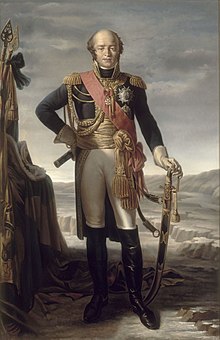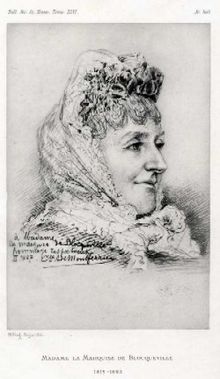Phare d'Eckmühl
| Phare d'Eckmühl | ||
|---|---|---|
| Place: |
|
|
| Location: | Finistère , Brittany , France | |
| Geographical location: | 47 ° 47 '53.5 " N , 4 ° 22' 22" W | |
| Height of tower base: | 4.8 m | |
| Fire carrier height : | 60 m | |
| Fire height : | 64.8 m | |
|
|
||
| Identifier : | Fl.W.5s | |
| Scope knows: | 25 nm (46.3 km ) | |
| Optics: | Fresnel lens | |
| Operating mode: | Halogen 650 W | |
| Function: | Orientation fire | |
| Construction time: | 1893-1897 | |
| Operating time: | since 1897 | |
The Phare d'Eckmühl is a lighthouse on the Pointe de Saint-Pierre in Penmarc'h in the French department of Finistère . The Phare d'Eckmühl, inaugurated on October 17, 1897, is one of the highest lighthouses in Europe at 60 m high. The tower secures one of the most dangerous coasts of France because of the many rocks. The walls of the tower are made of Kersanton granite , and the inner wall of the stairwell is covered with opal glass tiles. The tower is now one of the most visited structures in Finistère.
history
prehistory

The Phare d'Eckmühl was built next to two older lighthouses in the village of Saint-Pierre. The first thing that was created was an optical telegraph (sémaphore) , which was later called the Vieille Tour (“Old Tower”). In 1835 the Tour de Penmarc'h went into operation as a direct predecessor of the Phare d'Eckmühl. In a law of April 3, 1882, the French state decided to modernize its beacons on the coast, and in particular to connect the main lighthouses, including the Phare de Penmarc'h, to electricity. The new lighting concept provided for a height of 60 meters. The lighthouse was only 40 m high, however, and it turned out to be technically impossible to raise it as much as was necessary for the intended range of the beacon of an average of 100 km. In 1890 it was decided to build a new, 54.20 m high lighthouse. On October 6, 1892, the project was approved with a total cost of 110,000 francs.
Unexpected funding

On December 9, 1892, an unexpected windfall resulted in changes to the project. The Marquise Adélaïde-Louise d'Eckmühl de Blocqueville determined in her will a sum of 300,000 francs for the construction of a lighthouse. This lighthouse was to be named d'Eckmühl in honor of her father, Maréchal Louis Nicolas Davout , Duke of Auerstädt , Prince of Eckmühl. He owed this last title to the battle of Eggmühl , which he fought near the Bavarian village of Eggmühl . The Marquise wanted this name, full of sad memories, to restore its prestige through the lives saved thanks to the lighthouse:
"Les larmes versées par la fatalité des guerres, que je redoute et déteste plus que jamais, seront ainsi rachetées par les vies sauvées de la tempête."
She also wanted this lighthouse to be built on the Brittany coast and in a place where it would surely stand the test of time. After an investigation, a commission decided on the location at Pointe de Penmarc'h. In order to do justice to the wishes of the founder, the Parisian architect Paul Marbeau was called in to design the decoration of the tower - a first in the modern history of lighthouses.
Construction of the lighthouse
The lighthouse had a budget of 600,000 francs. It was to be built 122 m east of the old lighthouse. Construction began in September 1893 and was carried out by the Vabre company. The former house of the beacon keeper and a wayside shrine were demolished during the construction work.
The sand came from Toul ar Stêr, the building blocks from Poulgallec, the lime, the quality of which was strictly monitored, was obtained from lime kilns in Marans ; it was first transported by ship to Loctudy and from there by cart to Saint-Pierre. The Portland cement was obtained from Boulogne-sur-Mer . The Kersanton granite finally came from Brest , where it was first chopped into blocks and then brought across the sea to the port of Kérity by barge (French: gabare ) . The sea transport, preferred for financial reasons, was difficult and resulted in many delays and cost increases; it extended the overall construction time. But the shortage of workers, especially bricklayers and tilers, contributed to the delay.
The mortar layer of the foundations was covered with tar to prevent moisture from penetrating the masonry. The tower was built with the help of scaffolding. The granite blocks were lifted up using a steam engine . The tiles that cover the inner wall were assembled from scaffolding that was pulled up by a chain located in the center of the tower. Construction work was overshadowed by a serious accident when a chain broke on scaffolding and seven workers were injured in a ten-meter fall. One of them went blind from the acid he had just been handling.
Further history of the lighthouse
The inauguration of the lighthouse, which was originally planned for September 1895, had to be postponed due to various delays during construction and finally took place on October 7, 1897, the fifth anniversary of the donor's death, accompanied by numerous celebrations.
The centenary of the lighthouse in 1997 was celebrated with three days of celebrations.
Today the lighthouse is operated fully automatically, the last two lighthouse keepers quit their duties on October 19, 2007, two days after the 110th anniversary of the tower. The tower is open to the public and, with almost 58,000 visitors (2006), is the most visited tourist attraction in Pays Bigouden and the fifth most visited attraction in all of Finistère. In 2013 the record for the 'climb' of 47 seconds and 2 hundredths was set by Quentin Thomas. The competition usually takes place in mid-August. In 2016 Agathe Guillemot improved her own record for women to 1'10''64. Maxime Signorino now holds the men's record with 46''56.
architecture
The tower stands in a rectangular courtyard about 80 m by 60 m, which is surrounded by a wall. The wall on the north side, which is not directly exposed to the sea, was only erected in 1924 after a storm surge. The guards' quarters and the engine room are also located in the courtyard. The floor of the courtyard is decorated with two large, symmetrical stone images of anchors and five-pointed stars. The railing is made of polished bronze.
The lighthouse is constructed from bottom to top as follows:
- a square foundation one meter high
- a substructure of 9.43 m
- a base of 2.96 m
- the tower of 32.63 m
- a square ledge of 6.81 m
- a campanile of 4 m
- a lantern of 9.50 m
Its walls are made entirely of Kersanton granite and its windows are made of oiled French oak. To get up to the lantern you have to climb a total of 307 steps.
See also
Web links
- History of the Phare d'Eckmühl (fr)
- 110th anniversary page (fr)
- Description of the lighthouse (fr)
- Arte Karambolage from October 2, 2016, 7:35 p.m., accessed on October 5, 2016






